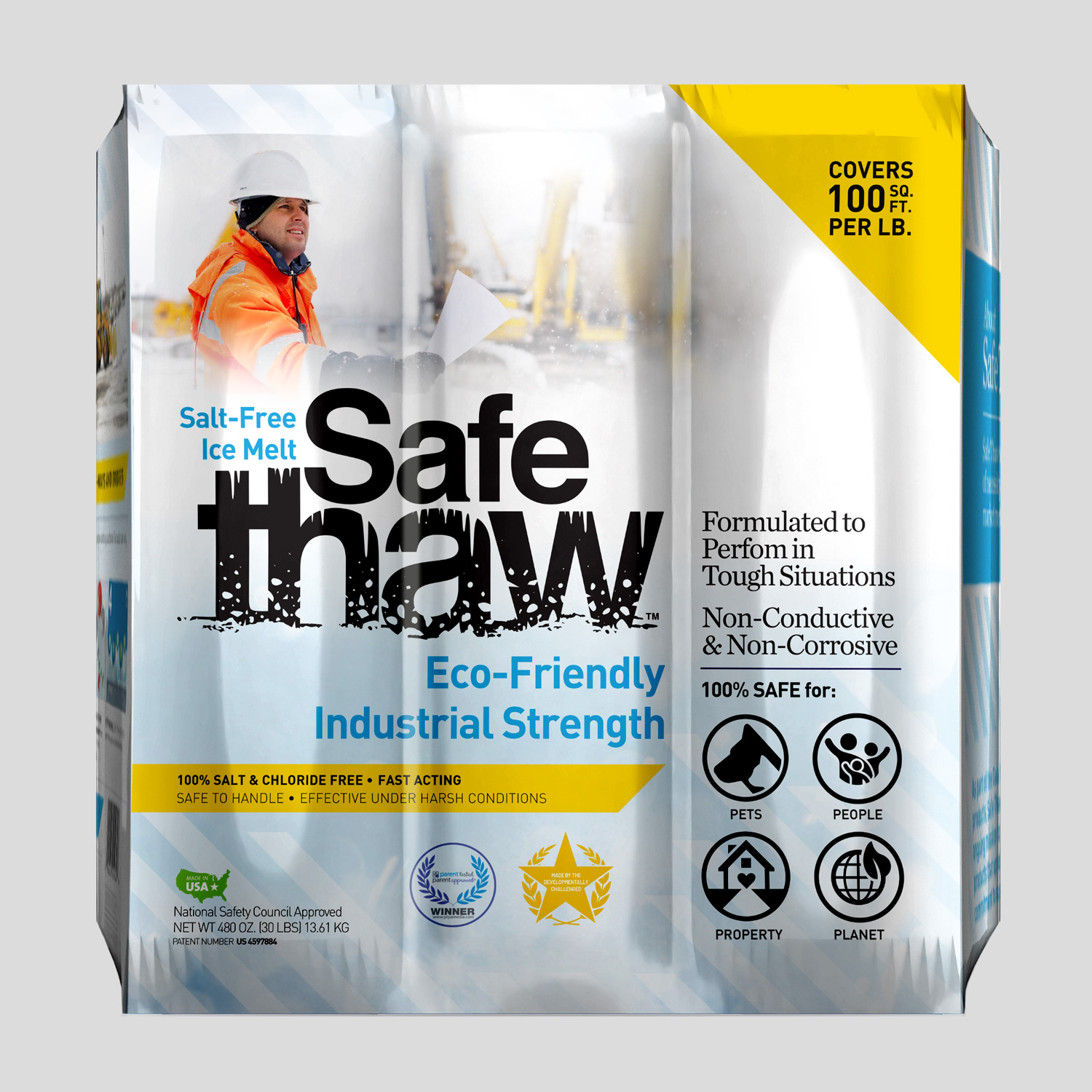DIY Dry Ice: A Simple 5-Step Method

Dry ice, the solid form of carbon dioxide (CO2), is known for its extremely cold temperature and unique properties. While many are curious about how to make a dry ice or how make dry ice at home, it’s important to understand the process and handle it safely. Here’s a straightforward guide to making dry ice, along with its negatives and a safer alternative for certain uses.

Safe Thaw
Safe Thaw was created as the ice management solution for tough winter environments. Ideal in commercial and industrial properties, shops, government agencies, bridges, and construction.
1. Understanding Dry Ice And Safety Precautions
Before delving into how to make a dry ice, it’s crucial to understand what dry ice is and the safety precautions needed. Dry ice is -78.5°C (-109.3°F) and can cause severe frostbite upon contact with skin. Always wear protective gloves and goggles, and ensure adequate ventilation as dry ice releases CO2 gas.
2. Gathering Necessary Materials
To begin the process of how make dry ice, you need a source of CO2. Typically, a CO2 fire extinguisher or a compressed CO2 tank is used, as these contain the liquid form of CO2, essential for making dry ice.
3. Releasing Co2 Into A Cloth Bag
Wrap a cloth bag around the nozzle of your CO2 source. When you release the CO2 quickly, it expands rapidly, and the drop in temperature causes it to freeze into tiny particles of dry ice. This is the key action in how to make a dry ice.
4. Collecting The Dry Ice
After releasing enough CO2 into the bag, you’ll find a collection of dry ice snow. It’s crucial to handle this with care, using tools rather than direct contact, to avoid frostbite.
5. Compressing Dry Ice Snow
If you need to form blocks or pellets, compress the dry ice snow using a press. This step in how make dry ice requires special equipment and should be done with caution due to the extreme cold.
The Negatives Of Using Dry Ice
While understanding how to make a dry ice is fascinating, handling and using dry ice come with risks:
- Handling Risks: Direct contact can result in severe cold burns.
- Asphyxiation Hazard: In enclosed areas, the sublimating CO2 gas can displace oxygen.
- Environmental Concerns: Improper disposal and excessive use can contribute to CO2 emissions.
Safe Thaw: A Safe And Environmentally Friendly Alternative
For those needing an ice melt solution, Safe Thaw presents a safe and eco-friendly alternative. Unlike the complexities of how to make a dry ice, Safe Thaw is simple to use and safe for various surfaces. It’s chloride-free and toxin-free, ensuring it’s non-corrosive and does not harm pets, plants, or humans. Safe Thaw’s patented formula is designed for efficiency and environmental safety, offering a superior choice for ice control without the risks associated with dry ice.
How Long Does Dry Ice Last And What Really Affects It?
After you’ve gone through the effort of making or handling dry ice, the next question almost always pops up: “how long does dry ice last?” The answer depends on several factors. Unlike regular ice, which melts into water, dry ice sublimates—meaning it turns directly into carbon dioxide gas. That means you won’t see puddles on your floor, but you will notice it shrinking away faster than you might expect.
So let’s break it down. If you’ve got a 5–10 lb block stored in a cooler, expect it to last somewhere between 12 and 24 hours. That’s the average window, but it can disappear much quicker if you’re constantly opening the cooler or if you’re keeping it in a warm room. Smaller pellets? They’re even more short-lived—often just a few hours before they’re gone completely.
The environment plays a huge role here. Air circulation speeds up sublimation. A block of dry ice sitting outside in a breeze will vanish much faster than one tucked away in an insulated container. And that brings up the most important tip: never store it in a sealed container. The temperature of dry ice in Fahrenheit is about -109.3°F. When something that cold sits in a closed container and starts releasing gas, the pressure inside builds rapidly. That can cause the container to rupture—sometimes violently. So while insulation is good, a locked lid isn’t.
Planning how long dry ice will last really comes down to how you’re using it. If you’re relying on it for shipping, always overestimate how much you’ll need. If you’re using it for special effects, like fog at an event, remember that the fog effect only lasts as long as the sublimation does. That leads to another question: “how long does dry ice smoke last?” Usually, the fog effect from dry ice in warm water lasts only about 5 to 10 minutes before it thins out, so you’ll need to add more pieces over time if you want the effect to continue.
Disposing Dry Ice: Why It Matters And How To Do It Right
Once you’ve used dry ice, the next concern is what to do with what’s left. Many people assume you can simply toss it into the sink or flush it down the toilet. But let’s clear that up—can dry ice go down the drain? The answer is no. Pipes are not designed to handle sudden blasts of extreme cold. At -109.3°F, dry ice can cause brittleness or even cracking in plumbing systems. And when the gas expands, it could create extra pressure inside your pipes. That’s a repair bill no one wants.
So what’s the proper way of disposing dry ice? The safest and easiest method is to leave it out in a well-ventilated outdoor space and let it sublimate naturally. If you’re impatient, you can add warm water to accelerate the process, but again—never in an enclosed area. Adding warm water speeds up sublimation dramatically, producing a dense fog, but remember that this releases large amounts of carbon dioxide gas quickly. Without proper airflow, it can displace oxygen and cause breathing problems.
How Long Will Dry Ice Last In Water?
Now here’s an interesting twist: what happens when you drop dry ice into water? Many people use this trick for Halloween fog effects or dramatic displays. The question becomes “how long will dry ice last in water?” The answer—much less time than if it were sitting in a cooler. Water transfers heat far more efficiently than air, which means the sublimation rate skyrockets.
A chunk that might last 24 hours in a cooler could be gone in less than an hour in a tub of water. The trade-off, though, is that you get that beautiful, rolling fog effect. That fog is actually condensed water vapor made visible by the rapid release of cold carbon dioxide gas. It looks dramatic, but it’s fleeting. So if you’re planning on using dry ice in water for an event, keep replenishing it.
And here’s a safety note: never put your hands in the water with dry ice. Even though the water buffers the extreme cold slightly, the temperature of dry ice in Fahrenheit is still enough to cause severe frostbite on contact. Always use tongs or protective gloves when adding pieces to water.
Balancing Curiosity And Practicality
It’s tempting to think of dry ice as just a fun science trick or party prop, but understanding how long dry ice lasts, how long dry ice smoke lasts, and the safe ways of disposing dry ice makes all the difference between curiosity and responsibility. It’s also about knowing when dry ice is the right solution and when it isn’t. For instance, if your main goal is de-icing a driveway or preventing slips during a storm, dry ice is not practical. It sublimates too fast, doesn’t spread evenly, and creates safety hazards.
That’s where alternatives come in. Products like Safe Thaw are specifically designed for real-world winter management. Unlike dry ice, which disappears quickly and comes with handling risks, Safe Thaw is stable, safe, and long-lasting. Its chloride-free, toxin-free formula makes it not only effective for melting ice but also safe for surfaces, pets, and the environment. For industrial or commercial settings where reliability matters, Safe Thaw eliminates the unpredictability that comes with handling frozen CO2.
100% salt & chloride-free, fast acting Ice Management Solution
Conclusion
Dry ice is fascinating, no doubt. Understanding how long does dry ice last, whether you’re asking how long will dry ice last in water or how long its fog effect lingers, helps you use it more effectively—and safely. But that fascination must be paired with caution. Knowing that dry ice cannot go down the drain, that its temperature in Fahrenheit is an extreme -109.3°F, and that disposing dry ice correctly is non-negotiable keeps both people and property safe.
And when the conversation turns from experiments and entertainment to practical winter safety, that’s where dry ice steps aside. For driveways, walkways, and industrial areas that need dependable ice management, Safe Thaw becomes the clear solution. It melts ice without risk, lasts longer, and supports environmental responsibility.
So while dry ice may capture your imagination, Safe Thaw is what keeps your winter safe. Think of dry ice as the science show—and Safe Thaw as the everyday hero you can rely on when the snow and ice start to build.
Try Also Our Other Winter Safety Products:
Safe Paw
The Original and #1 Selling Pet and Child Safe Ice Melt for over 20 years. Guaranteed environmentally safe –It won’t harm animals or children, and it won’t damage your property. That’s Safe Paw. Safe Paw can change how winter affects our planet.

Walk On Ice
The handy disposable canister can be taken everywhere, with the same 100% naturally occurring minerals that provide instant traction on ice or snow. Use it on sidewalks, steps, or as an instant traction agent for your car.



